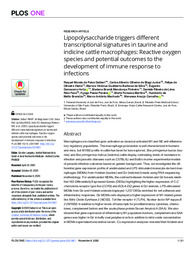Lipopolysaccharide triggers different transcriptional signatures in taurine and indicine cattle macrophages: Reactive oxygen species and potential outcomes to the development of immune response to infections.
Lipopolysaccharide triggers different transcriptional signatures in taurine and indicine cattle macrophages: Reactive oxygen species and potential outcomes to the development of immune response to infections.
Author(s): DAIBERT, R. M. de P.; BIAGI JUNIOR, C. A. O. de; VIEIRA, F. de O.; SILVA, M. V. G. B.; HOTTZ, E. D.; PINHEIRO, M. B. M.; REIS, D. R. de L.; PEREIRA, H. P.; MARTINS, M. F.; BRANDAO, H. de M.; MACHADO, M. A.; CARVALHO, W. A.
Summary: Macrophages are classified upon activation as classical activated M1 and M2 anti-inflammatory regulatory populations. This macrophage polarization is well characterized in humans and mice, but M1/M2 profile in cattle has been far less explored. Bos primigenius taurus (taurine) and Bos primigenius indicus (indicine) cattle display contrasting levels of resistance to infection and parasitic diseases such as C57BL/6J and Balb/c murine experimental models of parasite infection outcomes based on genetic background. Thus, we investigated the differential gene expression profile of unstimulated and LPS stimulated monocyte-derived macrophages (MDMs) from Holstein (taurine) and Gir (indicine) breeds using RNA sequencing methodology. For unstimulated MDMs, the contrast between Holstein and Gir breeds identified 163 Differentially Expressed Genes (DEGs) highlighting the higher expression of C-C chemokine receptor type five (CCR5) and BOLA-DQ genes in Gir animals. LPS-stimulated MDMs from Gir and Holstein animals displayed 1,257 DEGs enriched for cell adhesion and inflammatory responses. Gir MDMs cells displayed a higher expression of M1 related genes like Nitric Oxide Synthase 2 (NOS2), Toll like receptor 4 (TLR4), Nuclear factor NF-kappa-B 2 (NFKB2) in addition to higher levels of transcripts for proinflammatory cytokines, chemokines, complement factors and the acute phase protein Serum Amyloid A (SAA). We also showed that gene expression of inflammatory M1 population markers, complement and SAA genes was higher in Gir in buffy coat peripheral cells in addition to nitric oxide concentration in MDMs supernatant and animal serum. Co-expression analyses revealed that Holstein and Gir animals showed different transcriptional signatures in the MDMs response to LPS that impact on cell cycle regulation, leukocyte migration and extracellular matrix organization biological processes. Overall, the results suggest that Gir animals show a natural propensity to generate a more pronounced M1 inflammatory response than Holstein, which might account for a faster immune response favouring resistance to many infection diseases.
Publication year: 2020
Types of publication: Journal article
Unit: Embrapa Dairy Cattle
Observation
Some of Embrapa's publications are published as ePub files. To read them, use or download one of the following free software options to your computer or mobile device. Android: Google Play Books; IOS: iBooks; Windows and Linux: Calibre.
Access other publications
Access the Agricultural Research Database (BDPA) to consult Embrapa's full library collection and records.
Visit Embrapa Bookstore to purchase books and other publications sold by Embrapa.

